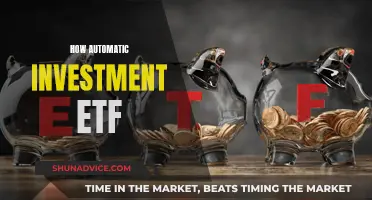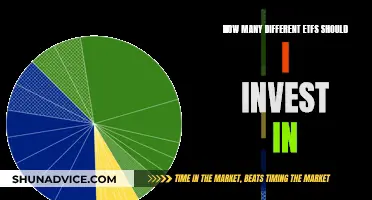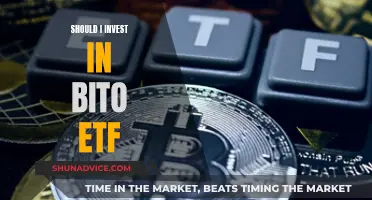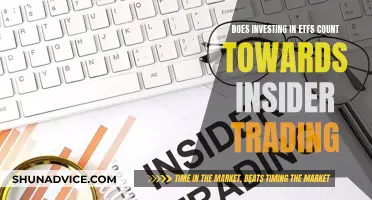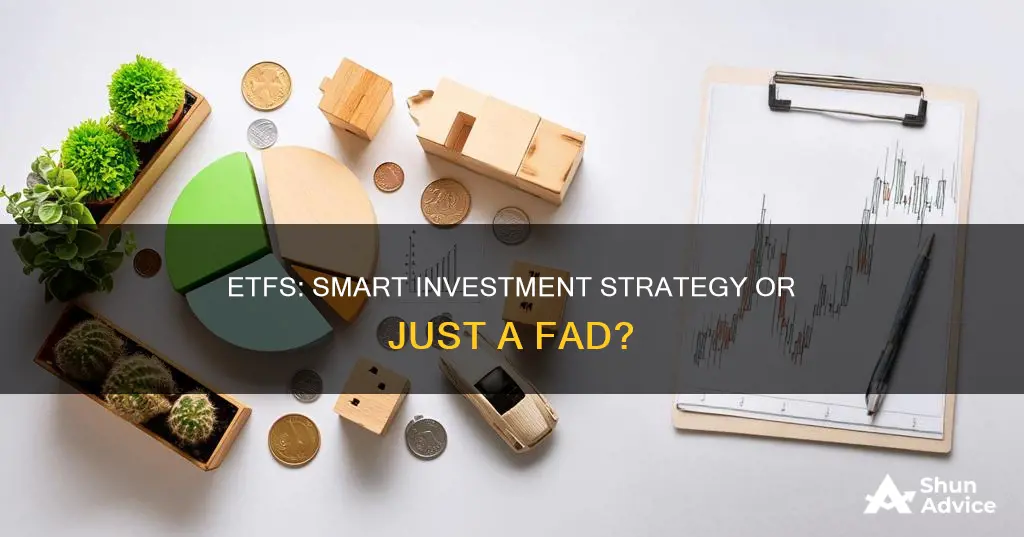
Exchange-traded funds (ETFs) are a popular investment vehicle for both active and passive investors. They are similar to mutual funds but trade like stocks, providing investors with low-cost access to a variety of asset classes, industry sectors, and international markets. ETFs are an easy way to begin investing, offering simplicity, broad market exposure, and impressive returns without much expense or effort. They are ideal for young investors with small amounts of capital and limited investment knowledge, as well as those looking to test the investment waters. ETFs are also suitable for those with lumpsum cash who are yet to decide how to invest it. However, ETFs are not suitable for every investor, and it's important to understand their advantages and disadvantages before investing.
| Characteristics | Values |
|---|---|
| Cost | Low |
| Risk | Low |
| Liquidity | High |
| Settlement | Real-time |
| Investment options | Commodities, international securities, options, futures |
| Management style | Passive or active |
| Tax advantages | Yes |
| Control | Low |
What You'll Learn

ETFs are a low-cost way to gain exposure to the stock market
Exchange-traded funds (ETFs) are an excellent entry point into the stock market for new investors. They are a low-cost way to gain exposure to the stock market, and they typically carry lower risks than individual stocks since a single fund holds a diversified collection of investments.
ETFs are similar to mutual funds in that they pool money from multiple investors to invest in a basket of related securities. However, ETFs trade like stocks on major exchanges such as the NYSE and Nasdaq. This means that instead of investing a set dollar amount, you choose how many shares you want to purchase.
ETFs are known for having very low expense ratios relative to many other investment vehicles. The expense ratio is a measure of what percentage of a fund's total assets are required to cover operating expenses each year. While this is not exactly the same as a fee that an investor pays to the fund, it has a similar effect: the higher the expense ratio, the lower the total returns will be for investors.
ETFs are also more liquid (easy to buy and sell) than mutual funds. Online brokers make it easy to buy or sell ETFs with a simple click of the mouse.
Additionally, ETFs can be safer than stocks because of their inherent diversification. If you buy shares of a stock and the company performs poorly, the value of your stock goes down. However, if you purchase shares of an ETF and one or two stocks in the ETF perform poorly, the other ETF holdings can offset those losses.
ETFs are a great way for people to test the investment waters. They are relatively inexpensive and tend to be less risky than investing in individual stocks.
Reliance ETF NV20: A Comprehensive Investment Guide
You may want to see also

They are listed on an exchange and trade like stocks
Exchange-traded funds (ETFs) are traded on major exchanges such as the NYSE and Nasdaq. They are bought and sold in the same way as stocks, with similar levels of liquidity. This means that investors can buy and sell ETFs whenever the stock market is open, and they can also enter advanced orders on the purchase, such as limits and stops.
The liquidity of ETFs means that they can be easily converted into cash, and they can also be used for intraday trading. This level of liquidity gives ETF investors an advantage over those who invest in mutual funds, which are priced only at the end of the business day.
The price of an ETF is determined by the highest price buyers are willing to pay (the bid) and the lowest price sellers will accept (the ask). As with stocks, many online brokers now offer commission-free ETF trades. However, investors may still pay hidden commissions in the form of payment for order flow (PFOF).
The ease of buying and selling ETFs, along with their low expense ratios, makes them a good entry point into the stock market for new investors.
Alternative Harvest ETF: A Smart Investment Move?
You may want to see also

ETFs are low-risk as they replicate a stock index, offering diversification
Exchange-traded funds (ETFs) are a great investment option for beginners and experts alike. They are considered low-risk as they replicate a stock index, offering diversification and eliminating exposure to individual securities risk.
ETFs are a low-cost way to gain exposure to the stock market. They are listed on an exchange and trade like stocks, providing liquidity and real-time settlement. ETFs are also flexible, allowing investors to sell short or buy on margins. They provide access to alternative investment options, such as commodities and international securities, and offer hedging opportunities not available with mutual funds.
ETFs are well-diversified, reducing the risk of investing in individual stocks. By tracking a stock index, ETFs allow investors to match the market's performance over time. This diversification also helps safeguard an investor's portfolio against market volatility. For example, if one company or sector performs poorly, the other holdings in the ETF can offset potential losses.
ETFs are also transparent, disclosing their holdings daily, and tax-efficient, incurring capital gains taxes only when the investment is sold. They are generally considered safer than stocks due to their inherent diversification and are a great way to gain exposure to a variety of stocks, bonds, and other assets at a minimal expense.
However, it is important to note that ETFs are not suitable for every investor. They may carry commission fees and potential liquidity issues, and there is a risk of the ETF closing if it doesn't bring in enough assets to cover administrative costs. Additionally, ETFs may distribute capital gains to shareholders, creating a tax liability, and they may trade at a premium or discount to their underlying value.
Marijuana Index ETF: A Smart Investment Strategy
You may want to see also

They offer flexibility in how you trade
Exchange-traded funds (ETFs) offer investors a great deal of flexibility in how they trade.
Firstly, ETFs can be traded at any time during the trading day, whereas mutual funds are priced once per day and are typically purchased directly from the issuer. This means that investors can take advantage of fluctuations in the market throughout the day and enter advanced orders on the purchase, such as limits and stops.
Secondly, ETFs allow investors to choose how many shares they want to purchase, rather than investing a set dollar amount. This provides flexibility in terms of the level of financial commitment.
Thirdly, ETFs offer investors the opportunity to sell short or buy on margins, providing further flexibility in terms of risk management and potential profit.
Finally, ETFs provide access to a wide range of alternative investment options, such as commodities and international securities, which may not be available through mutual funds.
Overall, ETFs offer a high level of flexibility in terms of when, how, and what investors can trade, making them an attractive option for those seeking to have more control over their investments.
Warren Buffet's Take on Investing in ETFs
You may want to see also

ETFs are not suitable for every investor
While ETFs are a great way to enter the stock market, they are not suitable for every investor. Here are some reasons why:
ETFs are not suitable for investors looking for high returns
Due to their inherent diversification, ETFs do not offer the same return potential as individual stocks. If you are looking for high returns, investing in individual stocks may be a better option.
ETFs are not suitable for investors who want control over their portfolio
With ETFs, investors do not have a say in the individual stocks included in the fund. This lack of control can be a limitation for investors who want to avoid specific companies or industries for moral or other reasons. If having a highly personalised portfolio is important to you, individual stocks may be a better option.
ETFs are not suitable for investors who are not comfortable with volatility
While ETFs are often lauded for their diversification benefits, it is important to note that they are not immune to volatility. The potential for large swings will depend on the scope of the fund. For example, an ETF that tracks a specific industry or sector is likely to be more volatile than one that tracks a broad market index. Therefore, it is crucial to understand the underlying risks associated with the ETF before investing.
ETFs are not suitable for investors who want to minimise taxes
Investing in ETFs through a standard brokerage account can result in taxable income. Any gains made from selling an ETF will be subject to capital gains tax, and dividends received may also be taxable. While investing in ETFs through an IRA can help mitigate these taxes, it is important to consider the tax implications before investing.
ETFs are not suitable for investors who are not comfortable with their complexity
ETFs have some unique risks and considerations that investors should be aware of. For example, ETFs may distribute capital gains to shareholders, creating a tax liability. Additionally, the price of an ETF can sometimes differ from its underlying value, leading to a premium or discount for investors. The complexity of ETFs may be overwhelming for some investors, who may prefer the simplicity of other investment options.
A Guide to Investing in Nanc ETF: Tips and Strategies
You may want to see also
Frequently asked questions
ETFs are a low-cost way to gain exposure to the stock market. They are listed on an exchange and trade like stocks, offering liquidity and real-time settlement. ETFs are also low-risk as they replicate a stock index, providing diversification. They offer flexibility in trading styles and access to alternative investment options, such as commodities and international securities.
ETFs may not suit every investor. They are less personalised than investing in individual stocks and do not offer the same level of control over the specific stocks in your portfolio. ETFs also carry costs beyond the initial investment, such as expense ratios, management fees, and commissions.
You will need to open a brokerage account and choose your first ETFs. It is recommended that beginners opt for passive index funds, which are cheaper and often outperform their actively-managed counterparts. Examples of ETFs for beginners include the Vanguard S&P 500 ETF and the Schwab U.S. Mid-Cap ETF.
When choosing an ETF, consider the administrative expenses (expense ratios), trading volume, holdings, performance history, and trading prices. Compare different ETFs using screening tools offered by most brokers to find the best fit for your investment goals and risk tolerance.


